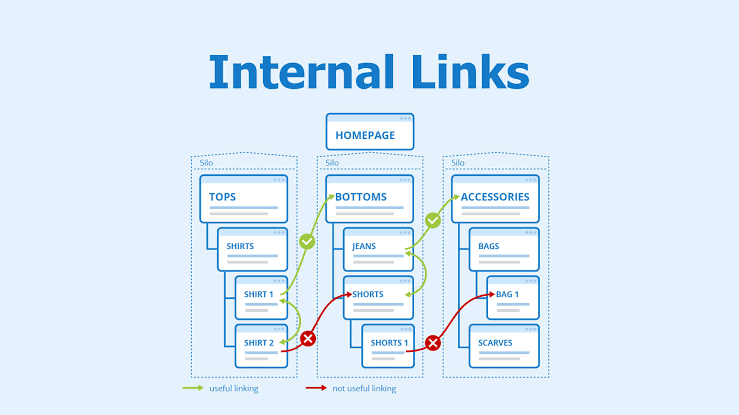Internal links are chains that connect every page of a website. When you break this chain, your website ends up looking meaningless. If a search engine crawler finds your website but fails to reach a landing page, it is likely that links are not visible.
As much as you understand the importance of internal linking, not having an effective strategy turns down your website conversions. And for this reason, learning some tips for internal link building is a good start for SEO in Melbourne.
In this blog, you will learn how evaluating website architecture, creating content-heavy pillar pages and topic clusters, using brief anchor text, location, and testing the links are trustworthy practices. So, continue reading the blog till the end.
But first, let’s get to the basics.
What is Internal Linking?
Internal links, as the name suggests, are links to other pages on a website. For example, a home page with CTA like “Contact Us” taking you to a contact form page is internal linking. Moreover, links on menus, sidebars, footers on a site are also a solid internal linking strategy.
Why Do You Need It?
Let’s now delve deeper into the relevance of internal linking for SEO in Melbourne.
- Internal links on a website help search engine crawlers to understand the site structure.
- It raises the ranking of every important page of a website.
- It helps visitors to understand and find products and services quickly.
- Adding well-planned internal links helps your website to be valuable and accessible to Google.
Best Tips to Add Internal Links
Now, let’s focus on building an internal link strategy and quick ways of implementing it.
- Evaluate Your Website Structure:
The best way to start adding relevant and valuable links on a website is to analyse the site hierarchy. As soon as you have your website ready, take a look at the most traffic-generating pages.
These are usually the home page, service page, and landing page, in case of service-based websites. And product-led websites accompany the home page, and multiple category pages followed by product pages.
Think about how you can connect these pages to one another, keeping in mind the context and relevancy. MMW SEO services are your ultimate solution to getting started with efficient internal linking strategies.
- Create Pillar Pages:
If you are creating your website for the first time, it is useful to write strong pillar pages. A pillar page is a standalone web page. It covers essential and comprehensive information of your website’s main keyword. For example, a web design company in Melbourne must have a pillar page content on “Ultimate Guide to Understand Web Design”.
- Expand Your Website’s Reach Through Topic Clusters:
Going by the same example, your website must also feature blogs and guides on “How to find the best web design company” or “Questions to Ask a Web Designer”. These blogs add supporting context to the pillar content. Consider taking MMW SEO services for more refined and advanced internal linking techniques.
Now when you have both types of content on your website, use pillar page content to add links of cluster content.
- Use Simple but Detailed Anchor Text:
You might question how to add links to any content page in the first place. And therefore, the answer is to use anchor text. These are key phrases that contain either only the keywords of the linked content or keywords with additional text.
For example, if you are linking a page with a title “Digital Marketing Strategies”, a simple anchor text would be “digital marketing strategies”. However, adding a CTA like Read on, Learn more, etc., turns it into a detailed anchor text. This draws readers attention and provides subtle hints about the other resources that can be useful.
- Location Matters:
The location of the internal links on a website is a crucial but most overlooked aspect. You must avoid placing links wherever it fits. Instead, adding links must always appear natural and add context to the written paragraphs.
The best tip is to place the links to the center of the content, but after the first and before the last heading. As you complete a paragraph or two, internal links make more sense. MMW SEO services offer effective internal linking strategies to rank every relevant content.
- Frequency is Crucial:
The ideal number of links on a website depends on the size and number of content-focused pages. However, aiming for at least 5 links throughout the website is mandatory.
Make sure that the internal links don’t add unnecessary fluff, decrease the loading speed of a page, and direct the reader’s focus away from the main content.
- Test the Links:
Just like web testing, testing the links after putting them throughout the website is your responsibility. To begin with, test every link to see if they are relevant to the linked content. You must not forget to check the loading speed, errors, or misleading links.
Any errors in your internal linking strategy puts the entire website at the risk of losing credibility and authority.
Final Words
As you see, SEO in Melbourne is incomplete without effective internal linking planning. As for every tip discussed above, it is important to make sure that you reach out to a professional SEO expert.
If you are already exploring SEO companies in Melbourne, Make My Website is an award-winning and leading name for comprehensive and data-driven SEO strategies.
Stay in touch to get more updates & news on nhentainef.com!
